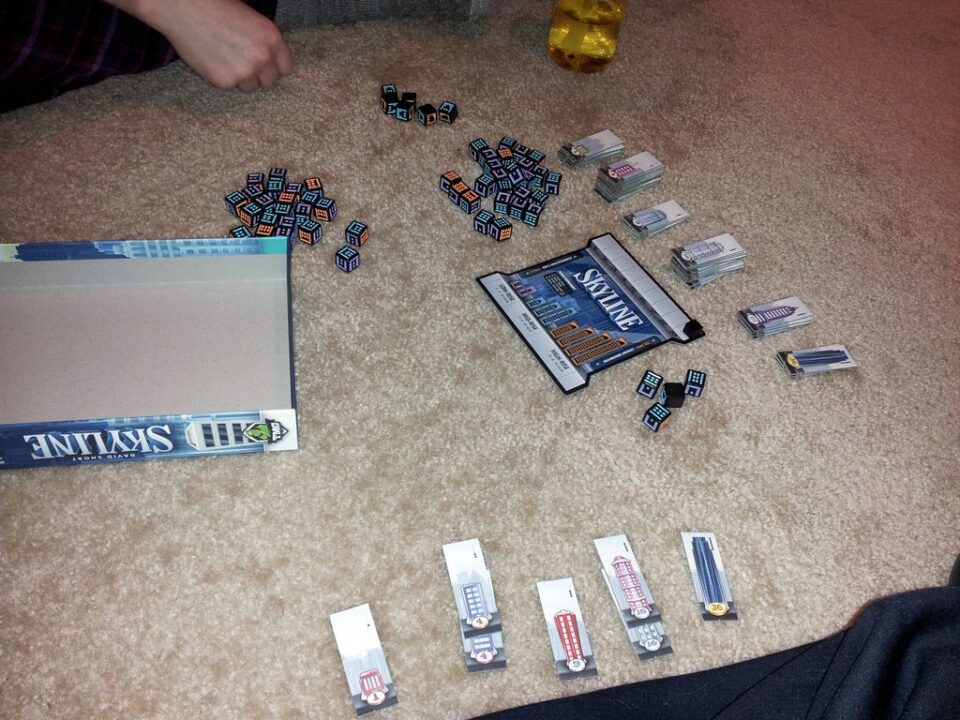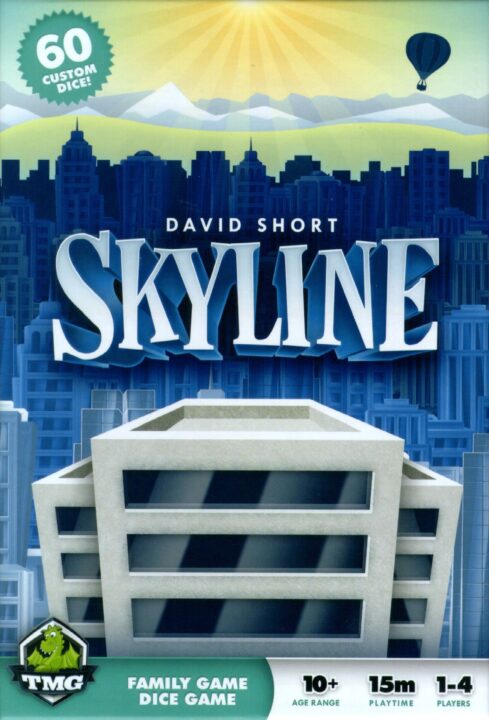Hey there, board game lovers! Today, I’m sharing my review of a game that had my friends and me building, strategizing, and occasionally arguing over who had the better skyline. Yes, I’m talking about the board game Skyline. Buckle up, because we’re about to unpack what makes this game tick, from its mechanics and balance to its components and replay value.
How It Plays
Setting Up
First, set up the game board in the center. Each player gets three dice and a set of building cards. Shuffle the resource deck and place it next to the board. Everyone picks a color and takes the matching skyline pieces.
Gameplay
Players take turns rolling their three dice. The dice results determine which resources they can collect. Players then use these resources to build parts of their skyscrapers on the grid. Each building card has specific requirements and gives points when completed. The game has a mix of strategy and luck, as dice rolls vary each turn.
Winning the Game
The game ends when a player finishes building their skyscraper, or the resource deck runs out. Players tally their points from completed buildings. The one with the highest score is the winner. It’s all about balancing resource management and perfect timing!
Want to know more? Read our extensive strategy guide for Skyline.
Gameplay Mechanics in ‘Skyline’
When we got our hands on ‘Skyline’, the first thing we noticed was how easy it was to get started. You don’t need a PhD to understand the rules, which is a big plus. ‘Skyline’ is all about building skyscrapers in a bustling city. The game is jam-packed with different mechanics that keep you on your toes.
First off, let’s talk about the dice. Dice rolling can sometimes be pretty hit or miss, but in ‘Skyline’, they add a layer of excitement. You roll to determine which building pieces you can use. It’s kind of like a game of chance with a twist of strategy. I remember one game night where my buddy Dave couldn’t roll a specific piece to save his life. We had a good laugh, but it didn’t leave him out of the game. He adapted his strategy and built another type of structure instead.
Another great mechanic is the resource management. You need to collect different materials to complete your skyscrapers. Think of it like cooking with limited ingredients. Do you use your steel now, or save it for a bigger project? It makes you think ahead, but it doesn’t bog you down with too much planning. I once got greedy and saved up, only to have my friend swoop in and snatch a building piece I needed. The friendly (or not-so-friendly) competition keeps everyone engaged.
The game also features a dynamic city grid. Placing your buildings on the board can block others or open up new opportunities. It adds a tactical element that keeps the game from feeling repetitive. Just when you think you’ve got the perfect spot, someone else might slip in and mess up your plan.
The variety of mechanics in ‘Skyline’ keeps it fresh and fun. Now, let’s talk about how fair and balanced this game really is.

Balance and Fairness in Skyline
Let’s talk balance and fairness in Skyline. This board game has its ups and downs, much like a real skyline! The game does a decent job of balancing player advantages and disadvantages. Each player starts with the same resources and opportunities, so you’re not doomed before the first roll of the dice.
Speaking of dice, here’s where things get a little shaky. The dice rolls introduce a luck element that sometimes feels overly significant. I’ve had games where one player keeps rolling sixes while another can’t catch a break, which makes the whole experience more dependent on luck than skill. This can be frustrating, especially for folks who cherish strategic gameplay. The dice mechanic lacks a bit of finesse when it comes to fairness.
Resource management is decent, though. The game provides enough choices to keep everyone involved. Players collect resources and build various parts of their skyline, competing for the tallest, most impressive structures. The catch is, no player can build the perfect skyline without some help or clever strategy.
The game does offer opportunities for tactical moves, but it sometimes feels like those tactics can be overshadowed by a lucky roll. For example, one time my friend Pete was on a roll (pun intended) and managed to build a massive skyscraper, while my carefully planned but unlucky strategy crumbled like a cookie in milk.
Overall, Skyline has a fair balance of skill and luck, but it leans more towards the latter. It’s fun, especially if you don’t mind a bit of randomness. However, if you detest games where luck plays a big role, this might not be the game for you.
Now let’s talk about something solid: the component quality in Skyline.
Stellar Components Elevate Skyline
Skyline isn’t just a board game; it’s a piece of art. When you first open the box, the components scream high-quality. The dice, which are a core part of the gameplay, are solid, not flimsy. They’ve got a good weight and roll smoothly. None of that cheap, plastic feel you sometimes get in other games. The player boards are thick, and the grid where you place your buildings is clear and sturdy.
Now, let’s talk buildings. The miniatures in Skyline are top-notch. Each piece is crafted with attention to detail, making you feel like a mini architect. They fit nicely on the grid, and there’s no awkward wobbling. The colors are vibrant but distinct enough so you won’t mix up your pieces with someone else’s in the heat of the game.
The cards in the game? Lamination dreams! You know how some games have flimsy cards that get dog-eared after a few plays? Not here. Skyline’s cards are durable, with a nice finish that resists wear and tear. Plus, the illustrations on the cards are a visual treat, pulling you even deeper into the game’s theme.
The box insert deserves a special mention. It’s designed to hold everything in place, which means set-up and tear-down are a breeze. No more digging through a jumbled mess of pieces. Everything has its place, and it makes getting the game to the table that much quicker.
So, if you’re a stickler for component quality, Skyline won’t disappoint. The developers really went above and beyond here, adding an extra layer of enjoyment to every play session. Next up, let’s see how Skyline holds up when it comes to replay value.
Skyline’s Replay Value: Worth Building Again and Again?
Ah, Skyline. The game where you’re an architect in the making, dreaming of constructing the tallest, shiniest skyscrapers. But, is it the kind of game you’d want to pull out often? Let’s break it down.
First off, the game’s versatility is a strong point. Playing Skyline feels fresh each time because it involves a mix of strategy and luck in each session. You’re building different cities with different priorities. One game may see you focus on height, while another has you fixated on style and aesthetic. This keeps it exciting.
Another plus is the multiple paths to victory. No two games play out the same way. One game you might rush for those high-value buildings, another you might play it safe and go for variety. This flexibility means you can try different tactics, keeping each game feeling new.
Skyline isn’t one of those games where once you’ve mastered a strategy, you can always win. Nope. The ever-changing dynamics make sure you and your mates are kept on your toes. There’s always a new strategy to try, which adds to its replay value.
Let’s talk about the game’s length. Skyline hits that sweet spot where it’s not too short to feel underwhelming, but not too long to overstretch its welcome. It’s perfect for a quick round or two after dinner, or an entire game night dedicated to building those epic skylines.
I’d say Skyline has good replay value. It keeps things fresh with its variety and strategy. If you’re a fan of city-building games and want something that won’t gather dust, Skyline’s worth a spot on your shelf.
Recommended? Definitely.
Conclusion
Alright folks, that wraps up our review of Skyline. This game shines with its accessible rules, engaging gameplay, and top-notch components. It offers a balanced experience with enough strategy to keep it interesting, yet simple enough for newbies. While luck plays a part, it doesn’t overshadow your skills. So, if you’re looking to build your own urban masterpiece, Skyline might just be the game for you. Happy gaming!


